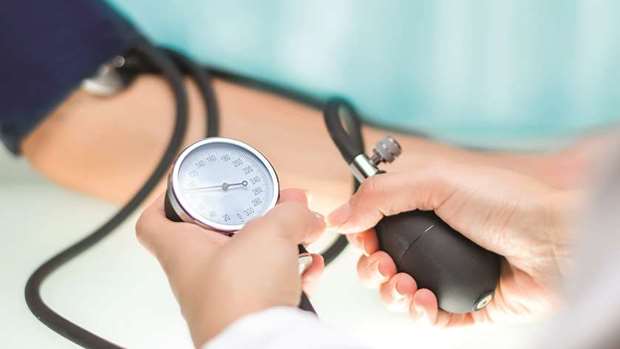Hypertension or persistently raised arterial blood pressure is one of the major risk factors for heart failure, myocardial infarction (heart attack), stroke and chronic kidney disease. A series of trials have proved that anti-hypertensive therapy can reduce the risk of stroke by at least 30% and risk of coronary heart disease by at least 20%. Management of hypertension requires a holistic approach involving multi factorial interventions targeting not only blood pressure, but all modifiable cardiovascular risk factors.
Hypertension is a condition where the blood pressure has exceeded the normal range. The pressure exerted by the column of blood on the wall of arteries is normally 120 (systolic pressure) over 80 (diastolic pressure) mm of Hg. Hypertension is one of the major causes of disability and death all over the world. It can cause heart attacks, strokes, kidney failures and other disorders, if neglected and untreated. In many cases, there are no symptoms until it causes complications such as heart attack and stroke. So, it is important to realise that you may have high blood pressure and the only way to find out is to get your blood pressure checked at regular intervals.
High blood pressure and hypertension
If the systolic (top) reading is sustained above or equal to 140mm of Hg or the diastolic (bottom) reading is sustained above or equal to 90mm of Hg or both, it is called hypertension.
A minimum of at least three readings are taken with the person quiet and seated, with the arm supported, using an appropriate size BP cuff, with adequate rest between the readings. Ideally BP is measured in both the arms. If the clinic BP remains 140/90 or greater, repeat BP check are done over the next several weeks with advice on lifestyle modifications.
How is hypertension diagnosed?
Hypertension is usually diagnosed by blood pressure monitoring in the clinic. The average ambulatory daytime blood pressure measurement is more reliable. Individuals can also monitor their blood pressure using standard home BP monitoring equipment.
Optimal blood pressure in an adult: 120/80mm of Hg
Normal blood pressure: 130/85mm of Hg
High normal blood pressure: >130/85 mm of Hg.
Stages of hypertension
Normal: Systolic less than 120mm Hg and diastolic less than 80mm Hg. No treatment is necessary, but you should monitor your blood pressure to be sure that it remains within the normal range.
Pre-hypertension: Systolic between 120 and 139mm Hg or a diastolic between 80 and 89mm Hg. people in this group have some risk of moving on to developing heart disease, we recommend lifestyle measures to try to prevent the onset of hypertension.” Lifestyle measures include exercise, managing body weight into a normal range, eating a diet high in fruits and vegetables, and choosing low-fat dairy products.
Stage 1: Systolic between 140 and 159mm Hg or diastolic 90 and 99mm Hg. Management includes the same lifestyle measures as with pre-hypertension and the use of one of a number of drugs that are known to not only reduce blood pressure but also to reduce the risk of heart disease and stroke.
Stage 2: Systolic 160mm Hg or higher or diastolic 100mm Hg or higher.
Causes of Hypertension
Primary or essential hypertension has no identifiable cause and accounts for 95% of patients detected with hypertension.
Secondary hypertension where there is a known underlying cause occurs in about 5% of patients.
The commonly detected causes being renal diseases like glomerulonephritis, renal artery stenosis, polycystic kidney disease, diabetic nephropathy , endocrine diseases like pheochromocytoma, cushing’s syndrome, thyroid disorders ,vascular conditions like coarctation of aorta, pregnancy (pregnancy induced hypertension or PIH), drugs and toxins like alcohol , liquorice present in herbal medicines, drugs like ephedrine, pseudo ephedrine present in many of the over the counter cold and cough preparations , non-steroidal anti-inflammatory drugs, corticosteroids etc.
Misuse of alcohol is the most common individual secondary cause for hypertension. Complete abstinence from alcohol lowers the blood pressure within 3 to 4 weeks.
Hypertension Treatments
The target varies depending on other associated conditions. If the patient has associated diabetes, the BP has to be maintained 140/80. In non-diabetics, the BP target is 140/85.The mean daytime ambulatory BP measurements and home measurements should be a little lower 130/75 in diabetics and 130/80 in non-diabetics.
The initial review after starting the anti-hypertensive treatment is within a month’s time. If BP is controlled, then the patient can be reviewed once in three month interval. If BP is not controlled, the patient needs more frequent reviews in order to adjust the dosage of medication or to add an additional medication. Most patients may need more than one drug.
Annual follow-up of the hypertensive patients is done to ensure compliance with treatment and to check for adequate blood pressure control, to look for signs of target organ damage if any, to assess and treat other modifiable risk factors for coronary heart disease or stroke and to reinforce lifestyle changes.
Diagnosing from Home
If the clinic BP readings are high, one can also monitor using standard equipment at home.
The person has to rest for at least five minutes, with the BP cuff over the arm placed at the level of heart and twice daily measurements are to be recorded for a minimum of 7 days and the average of these readings can be taken to confirm the diagnosis.
*Dr Jyothish Kumar,
MBBS, MD (General Medicine), Specialist – Internal Medicine,
Aster Medical Centre
Al Rayyan

.


